
Steamboat Ephemera - Misc.
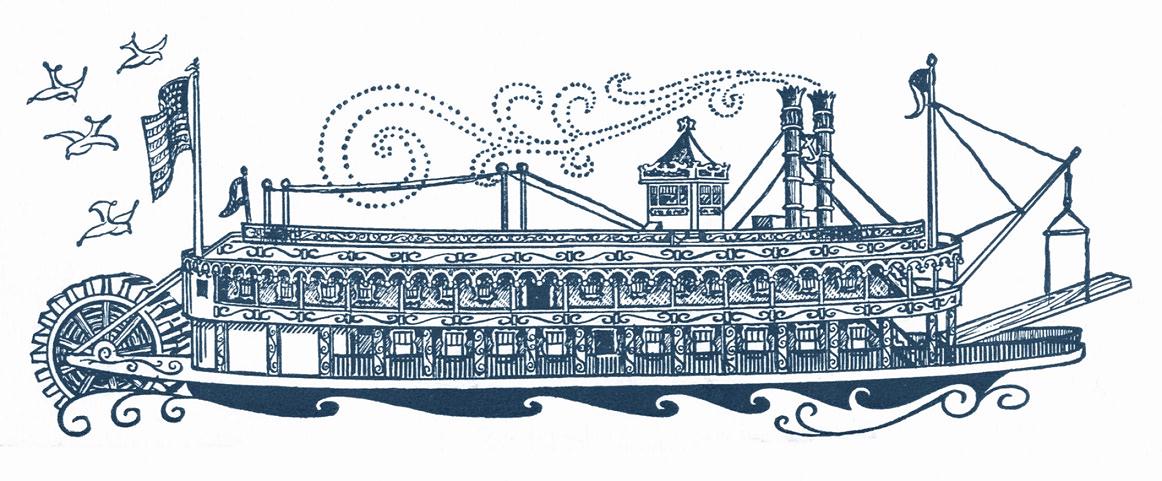
Graphic for an invitation to a cruise on the ADMIRAL at St. Louis 1950's
This graphic is off an invitation that measures 9.20 x 11.80 inches which when unfolded with a woodcut style designed graphic of a steamboat on the front "fold down" which was 4 x 11.80 inches when closed AND had 5 holes cut into it that revealed 5 names of ladies inside the card who were members of a party of people in St. Louis who were going on a cruise aboard the ADMIRAL circa the late 1950's (that was the eBay dealer's guess for the approximate time frame).
In the original the graphic was printed in red ink and there where the holes die-cut in front of the card which revealed the first names of the five ladies. I have reformatted the graphic to make the style of the boat more "traditional" in its proportions and changed the color from red to Navy Blue. Of course the boat didn't resemble the ADMIRAL either which I always thought looked like a gigantic upside down stainless steel bath tub, something rather in the Art Deco style by fashion designer Maizie Krebs in 1933 as the new flagship for Streckfus Steamers commissioned by Joe Streckfus
The text on the inside of the invitation reads:
"Ship Ahoy!
The Five Belles
(Cynthia Boyd, Marylee McDonough, Tony Reuter, Kathy Ring and Judy Sauer) are sailing on the S.S. Admiral We hope you will join us in our fun and folderol
September the third at nine P.M. is the time for all the gentlemen to bring their ladies in dress apropos Come as a Gambler, a Rogue or a Beau A Southern Belle or Ravishing Damsel whichever you choose we will give you a whirl"
Susan Meier, who may have been the social secretary for this Ladies Club, signed her name in pen and ink at the bottom of the page And below that is printed:
"R.S.V.P.
Mrs. E.N. Bell
3441 Klocke Street
St Louis 18, Mo."
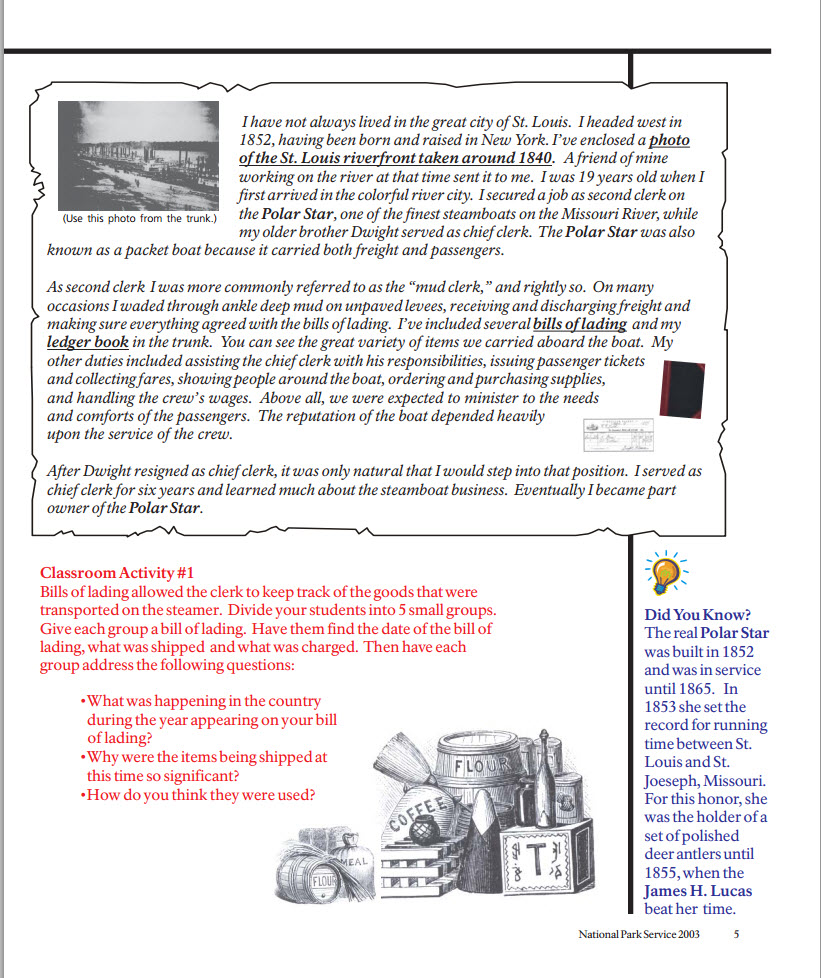
National Parks study plan to introduce school children to Steamboat History!
Recommended for educators seeking a study plan to teach steamboat history to school kids! Contact: nps.gov
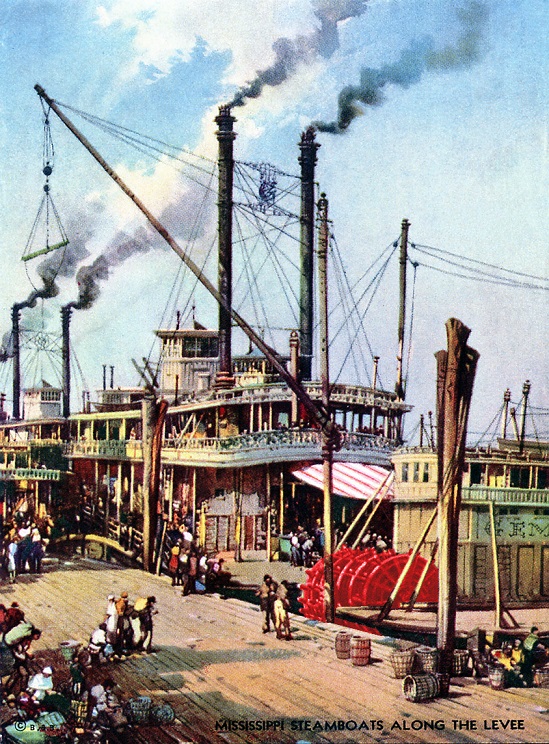
Graphic on a desk blotter depicting "levee boats" . . . the artist had a curious style that is unusual for the subject matter.
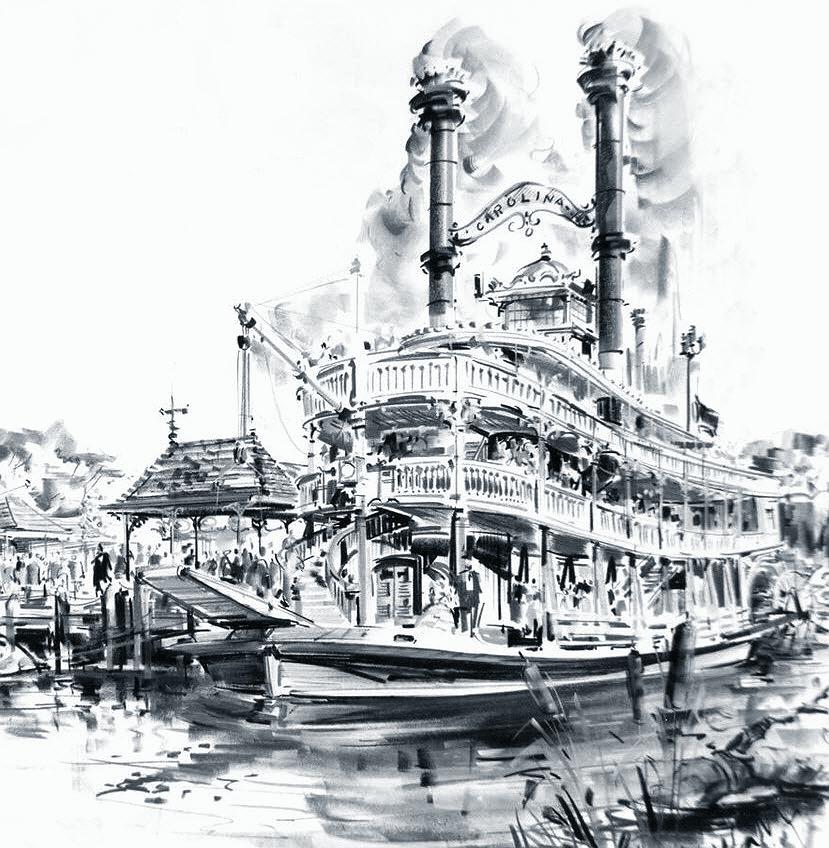
CAROWINDS Charlotte NC and the CAROLINA sternwheeler
Wikipedia
Carowinds is a 400-acre amusement park, located adjacent to Interstate 77 in Charlotte, North Carolina. Although having an official North Carolina address, the park is located on the state line of the Carolinas, with a portion of the park also located in Fort Mill, South Carolina. carowindsearlyyears.com
The Carolina Sternwheeler was an impressive paddle boat that docked in Plantation Square for the CAROWINDS theme park's during its first 30 years.
This relaxing trip for up to 400 passengers would take you by each of the park's 7 themed areas. Music was provided on board by the Dixieland Band. The water in the lagoon was only 6 feet deep and the boat traveled on a rail beneath the water. The Sternwheeler was removed after the 2003 season and replace by of a new flying roller coaster named Nighthawk (formerly known as BORG Assimilator)
carowindsearlyyears.com
E. Pat Hall, a Charlotte industrial developer, stunned the Carolinas on October 10, 1969 when he announced his plans to build a $250 million theme park and resort development that would straddle the NC/SC border near Interstate 77. Seven themed areas would depict more than 200 years of colorful Carolina history!
The $30 million theme park would be designed by Randall Duell & Associates of Santa Monica, CA., the same folks who designed Disneyland. A series of artistic renditions were released to the public in 1969 and ground was finally broken on May 1, 1970. The General Contractor was Charles Cisne & Associates of Charlotte. Their plans were to have the park open in April 1972, but rainy weather caused numerous construction delays.
Carowinds finally opened it's gates to the public on a rainy, March 31, 1973 at 9:36am. About 3,100 people passed through the turnstiles on that rainy, opening day, much less than the 25,000 anticipated. Fortunately, the first season ended with an impressive 1.2 million visitors, a record it held for a number of years when the impending oil crisis substantially hurt the travel and tourism industry. And amid the multiple park ownerships & personnel changes, come the inevitable and often drastic transformations that are necessary to remain fresh and competitive. The old Carowinds today, is barely recognizable with the exception of a few original rides and buildings. All of the down home, local charm that made Carowinds that special place it was back then, are long gone.
Many of those who visited Carowinds in it's hey day may recall certain thrill rides like the Surfer, the Witchdoctor or White Lightnin'. Others will remember the exquisite Double-Decker, German-made carousel, the Carolina Sternwheeler, the Monorail or the 2 authentic Steam Engine trains. And others may simply remember the Cable Skyway, a spin on the Oaken Bucket or the trams that would take guests to the former Plantation House entrance.
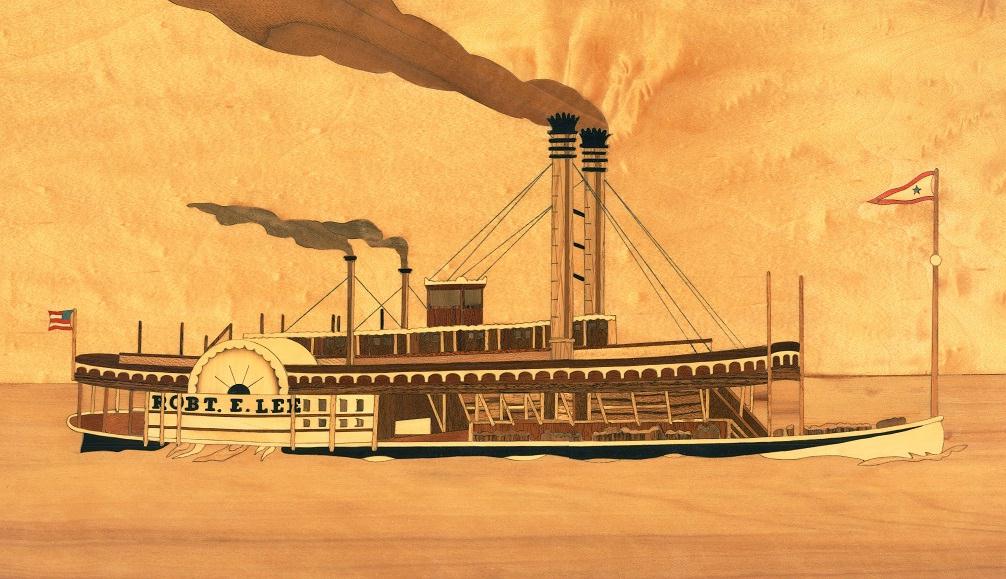
Wooding up the ROB'T E. LEE
Looks like a lot of man hours went into this 13 3/4 X 22 inch wood Marquetry Inlay plaque of the steamer ROB'T E. LEE signed by "VERN - 1983." Yay, Vern!
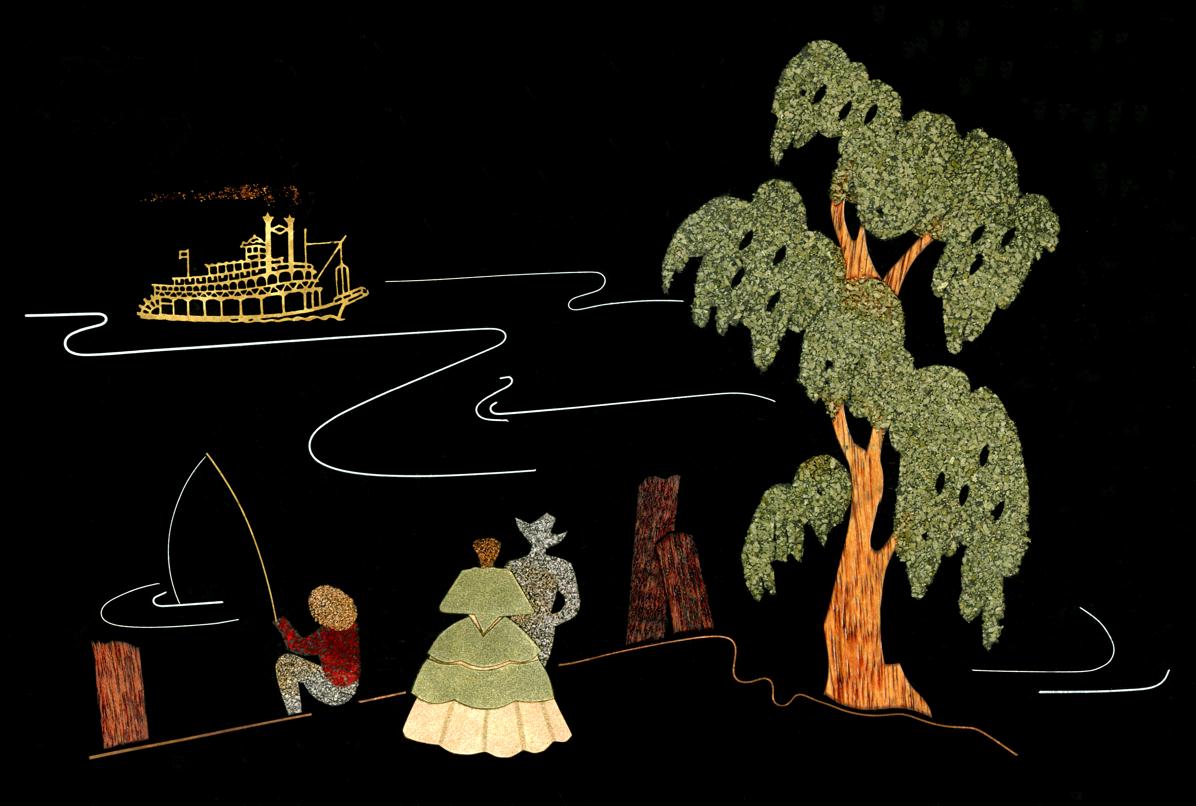
Vintage Couroc tray depicting a Mississippi riverboat scene
Vintage inlaid tray by Couroc depicting a Mississippi River steamboat in gold outline upper left. People on the bank with trees and one person is fishing at a dock. A boy is fishing left and a couple standin dressed in antebellum costumes in foreground. Measures 12 1/2 X 18 inches.
Tricky to scan and remove dust and scratches from black area. Brightened all the color components separately, captured them then pasted them into a darkened scan where the dust and scratches had been mostly subdued then spotting was needed to removed the remaining white dust.
The Couroc Company, founded in 1948 in Monterey, CA, produced beautiful and often whimsical black resin trays and glassware made by skilled artisans. See: thehourshop.com/collections/couroc
Couroc's founder, Guthrie Courvoisier, worked with a variety of plastics while working in the war effort during WWII. He used his experience and developed a proprietary formula of phenolic resin material that was not only durable enough to form into trays but was also impervious to alcohol and flames. Courvoisier's wife, Moira Wallace, acted as Couroc's chief designer and led an art commune of skilled artisans in arranging an array of local items into Couroc's resin pieces. Couroc's products were very popular and sold in high-end department stores. Alongside its whimsical designs, the company's saying for its trays stated that "Any tray can serve a drink. Only Couroc can start a conversation."
The company closed in the early 1990s.
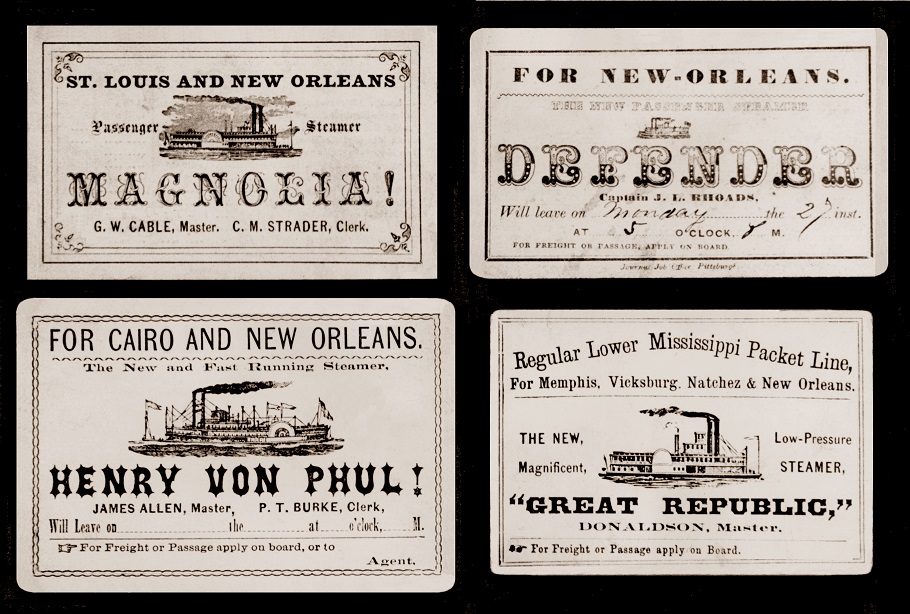
Antebellum Steamboat Cards MAGNOLIA, DEFENDER, HENRY VAN PHUL & GREAT REPUBLIC
Antebellum Steamboat Cards:
MAGNOLIA, DEFENDER, HENRY VAN PHUL & GREAT REPUBLIC
MAGNOLIA (1859-1868)
Sidewheel Packet
Way's Packet Directory Number 3698;
Built in 1859 at Cincinnati, Ohio
Owner and Master was Captain James H. Prather
First home port, Cincinnati, Ohio. She ran Cincinnati-Maysville.
On March 18, 1868 while upbound after leaving the landing at California, Ohio, her boilers exploded and the towboat PANTHER came to assist but 35 lives were lost. The burning wreck floated to Columbia before sinking.
DEFENDER
Sternwheel Packet
Way's Packet Directory Number 1483
Built Brownsville, PA 1855
1st homeport Pittsburgh
Sanagged and lost Apr 13 1860 at Laconia, Arkansas
HENRY VON PHUL
Sidewheel Packet
Way's Packet Directory Number 2608
Built 1860 at Paducah, Kentucky
Ran St. Louis - New Orleans
During the Civil War was a Hospital Boat Employed by the Union Army
Nov 15 1866 caught fire downbound above Donaldsonville, Louisiana.
GREAT REPUBLIC
Sidewheel Packet Boat
Way's Packet Directory
Number 2438
Built Shousetown PA and completed at Pittsburgh 1867
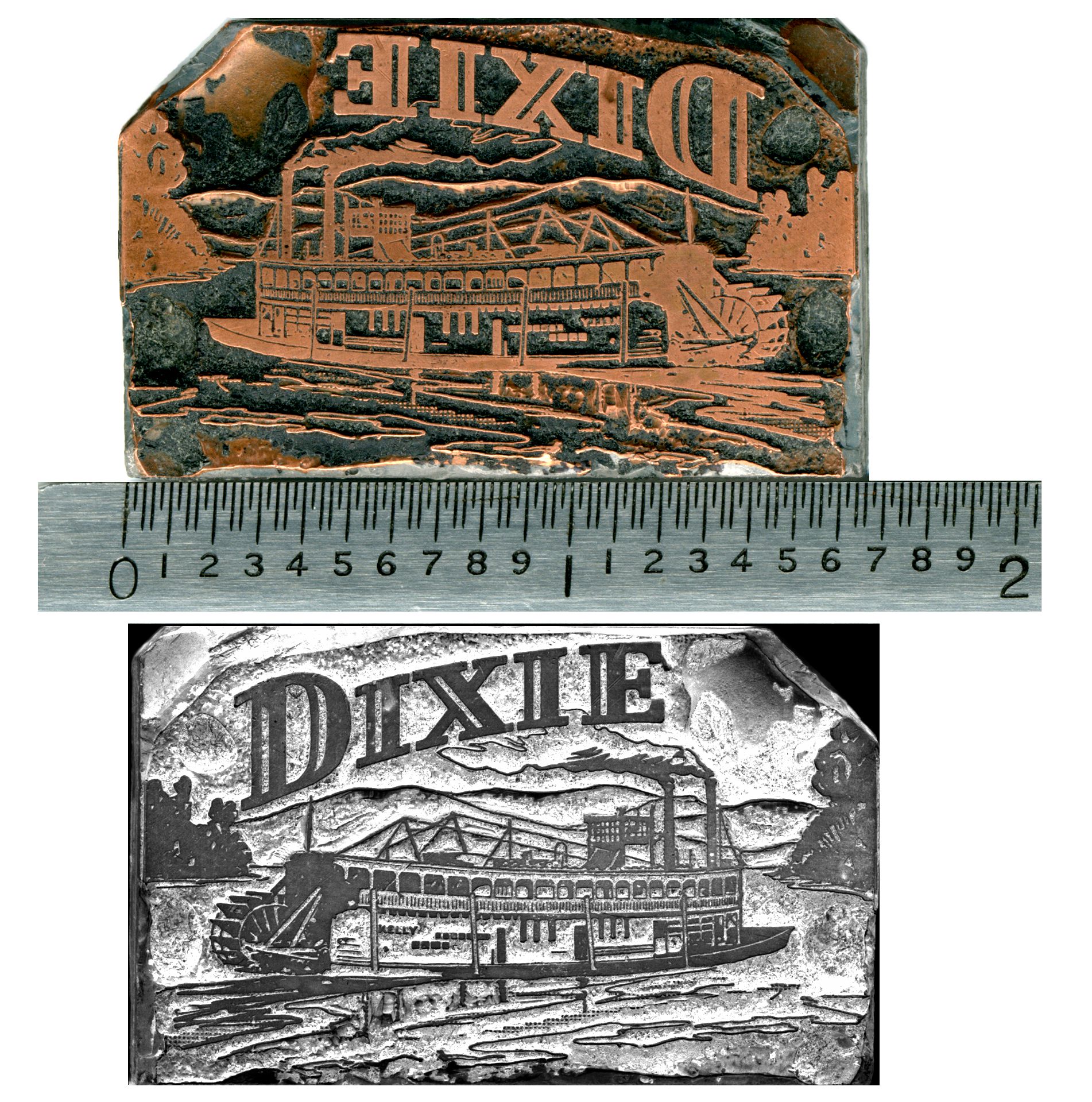
I "PROOFED" THE COPPER PLATED LEAD PRINTER'S BLOCK OF THE LITTLE STEAMER "KELLY" BY MAKING A MIRROR IMAGE OF IT IN PHOTO SHOP, CONVERTED IT TO GRAYSCALE AND ADJUSTED THE CONTRAST. SOMEDAY I'LL FIND A PLACE WITH A LETTERPRESS AND HAVE THEM MAKE A PROOF FROM THIS IN INK ON PAPER.
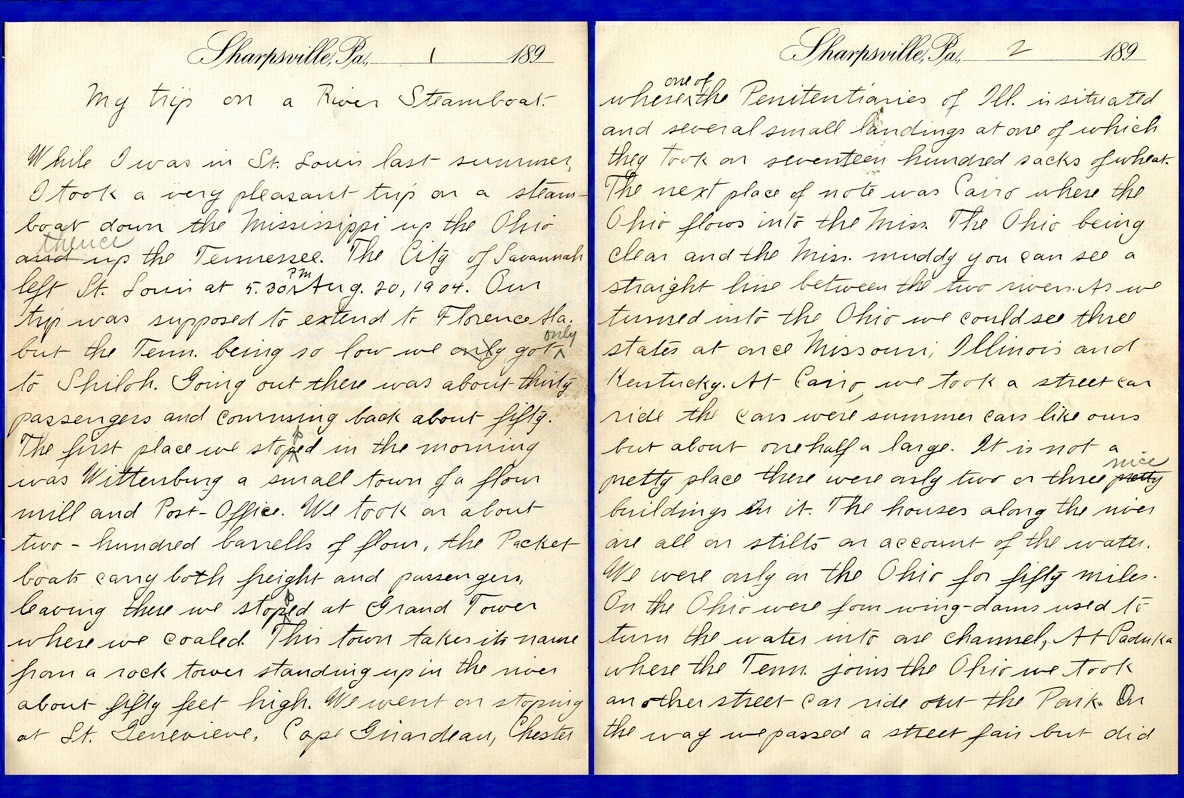
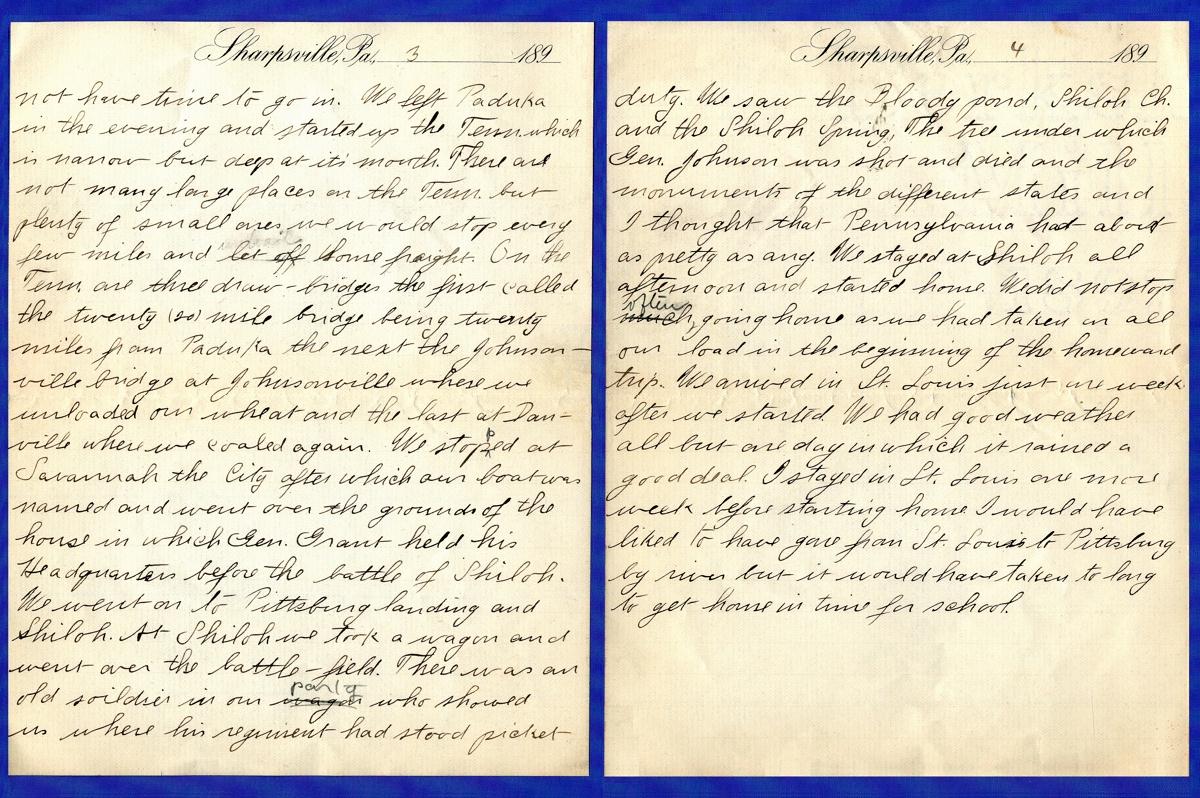
My trip on a River Steamboat. 1904
Transcript of a four page manuscript handwritten on Sharpsville, Pennsylvania stationery by an un-named Pennsylvania schoolboy about his trip on the steamboat CITY OF SAVANNAH commencing at St. Louis, Missouri on August 20th 1904, going down the Mississippi River to the Ohio and then up the Tennessee River to the Civil War battlefield at Shiloh.
My trip on a River Steamboat.
While I was in St. Louis last summer, I took a very pleasant trip on a steamboat down the Mississippi up the Ohio thence up the Tennessee. The CITY OF SAVANNAH left St. Louis at 5:30 PM Aug. 20, 1904. Our trip was supposed to extend to Florence, Alabama but the Tennessee being so low we got only to Shiloh. Going out there was about thirty passengers and coming back about fifty. The first place we stopped in the morning was Wittensburg a small town of a flour mill and Post-Office. We took on about two-hundred barrels of flour, the packet boats carry both freight and passengers, leaving these we stopped at Grand Tower where we coaled. This town takes its name from a rock tower standing up in the river about fifty feet high. We went on stopping at St. Genevieve, Cape Girardeau, Chester where one of the Penitentiaries of Illinois is situated and several small landings at one of which they took on seventeen hundred sacks of wheat. The next place of note was Cairo where the Ohio flow into the Mississippi. The Ohio being clear and the Mississippi muddy you can see a straight line between the two rivers. As we turned in into the Ohio we could see three states at once - Missouri, Illinois and Kentucky. At Cairo we took a street card ride, the cars were Summer cars like ours but about one half as large. It is not a pretty place, there were on two or three nice buildings in it. The houses along the river are all on stilts on account of the water. We were only on the Ohio for fifty miles. On the Ohio were four wing-dams used to turn the water into the channel. At Paducah where the Tennessee joins the Ohio we took another street car ride out to the Park. On the way we passed a street fair but did not have time to go in. We left Paducah in the evening and started up the Tennessee which is narrow but deep at its mouth. There are not many large places on the Tennessee but plenty of small ones. We would stop every few miles and upload some freight. On the Tennessee are three draw-bridges, the first called the twenty (20) mile bridge being twenty miles from Paducah, the next the Johnsonville bridge at Johnsonville where we unloaded our wheat and the last at Danville where we coaled again. We stopped at Savannah, the City after which our boat was named and went over the grounds of the house in which General Grant held his headquarters before the battle of Shiloh. We went on to Pittsburg landing and Shiloh. At Shiloh we took a wagon and went over the battlefield. There was an old soldier in our party who showed us here his regiment had stood picket duty. We saw the Bloody pond, Shiloh Church and the Shiloh Spring, the tree under which General Johnson was shot and died and the monuments of the different states and I thought that Pennsylvania had about as pretty as any. We stayed at Shiloh all afternoon and started home. We did not stop often going home as we had taken on all our load in the beginning of the homeward trip. We arrived in St. Louis just one week after we started. We had good weather all but one day in which it rained a good deal. I stayed in St. Louis one more week before starting home. I would have liked to have gone from St. Louis to Pittsburg by river but it would have taken too long to get home in time for school.
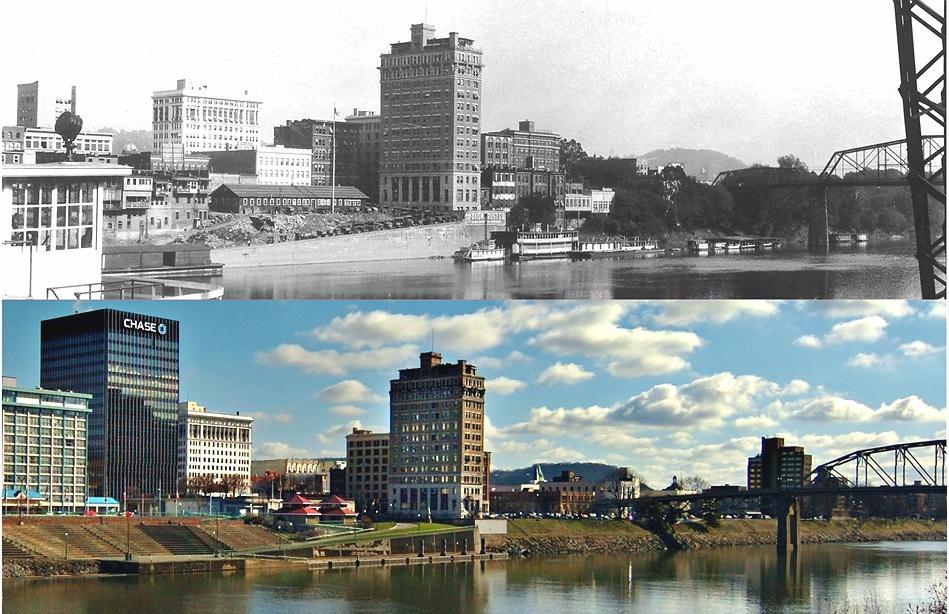

Charleston Daily Mail
Charleston, West Virginia
Monday, January 29, 2007
LOCAL HISTORIAN NOTES LANDMARK CRAFT, HOME OF OLD GENERAL SEAFOOD
This historic Charleston riverfront photograph was among a group of 45 recently purchased by California steamboat aficionado Dave Thomson.
The Sun Valley, Calif., resident collects model boats, photographs, documents and various other steamboat paraphernalia.
The Web site steamboats.com offers pictures from his collection.
When someone suggested this photo was of the Charleston, W.Va., riverfront, Thomson offered it to the Daily Mail for publication.
Local historian Richard Andre called this 1921 shot "a very interesting photo from an unusual vantage point."
"It was taken from the Ward ship yard and shows a riverboat pilot's cabin in the foreground while across the Kanawha River the rear of buildings along the Kanawha Boulevard live up to their reputation as eyesores."
Thomson says a close-up scan of the photo reveals the name "Edward's Moonlight" on the largest boat in front of the Union Building.
That's the same boat that in recent years served as a floating restaurant tied up at South Charleston's Riverwalk Plaza.
Now it has been pulled east to the Trojan Landing near the Patrick Street Bridge and is being renovated, again for use as a restaurant.
It was built in the late 1920s by Capt. Annis Boggs.
The spot where it is docked in the photo was known as Boggs' Landing.
It was towed by the Shamrock 2, the sternwheeler to the left of Edward's Moonlight.
Through the 1920s and 30s, the boat was used for dance cruises on the Kanawha River.
It was first called simply "Moonlight" and later rechristened "Edward's Moonlight" in honor of Boggs' son.
From the years of World War II through the mid 1980s, "Edward's Moonlight" was used for business purposes.
For many years it was leased by Amherst Industries and used as a dispatch barge.
Andre said the building with a row of windows just left of the Union Building is an old Army barracks donated to the Red Cross during World War I.
The Security Building is visible in the middle, and the Kanawha Banking and Trust tower can be seen to the left.
Also on the river at the levee is a wharf boat that served as a warehouse where steamboats could leave freight for local merchants, he said.
"This photo makes it obvious why the Boulevard was so welcome in 1940," Andre said.
In contrast, the recent river view photograph was shot by Daily Mail photographer Tom Hindman.
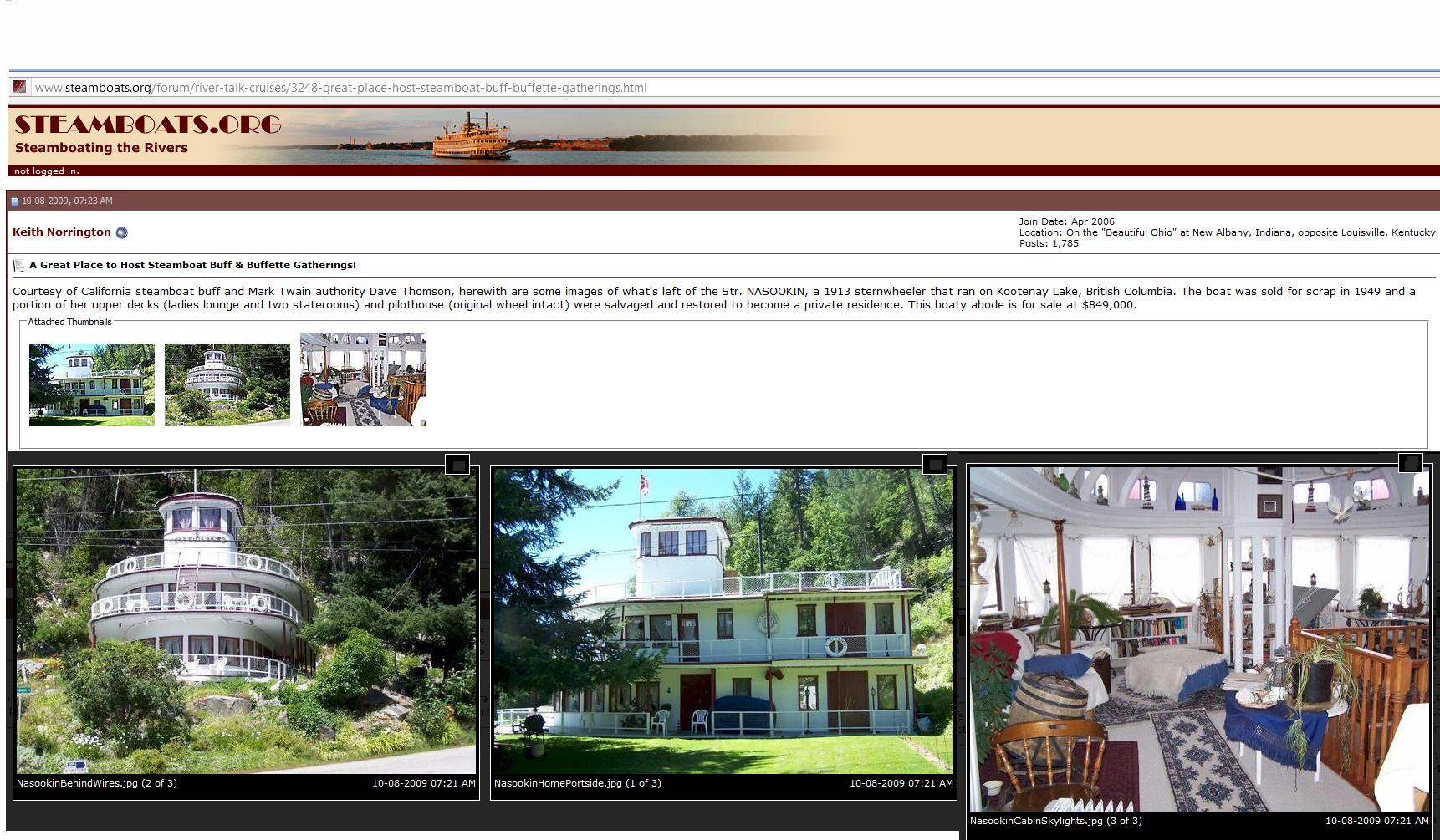
The Nasookin returns to Gray Creek nelsonstar.com
By Greg Nesteroff
The Nelson Star
October 06, 2011
Malcolm Metcalfe's earliest childhood memory is of being in the pilothouse of the SS Nasookin during the grand old ship's final days.
Once the largest sternwheeler on Kootenay Lake, it was by then a car ferry plying between Gray Creek and Fraser's Landing three times a day. Metcalfe's namesake grandfather, Malcolm MacKinnon, was its captain. Metcalfe recalls sitting on a shelf behind the ship's wheel.
"I remember my grandfather trying to get me to put my hand on this cord that came down from the ceiling and had a big tassel," he says. "I wouldn't touch it. So he pulled it, and of course it was the whistle. I screamed bloody murder."
That whistle blast is forever emblazoned in his memory - the only thing he can remember from that far back, much less with crystal clarity.
"My mother tells me I was two years old at the time. I told her that story, not the other way around. That's by far the earliest memory I have as a kid."
Metcalfe has a photo of himself with his grandfather, taken on that voyage, looking out the ship's front window.
He also has another memorable souvenir: the Nasookin's original wooden wheel. His grandfather received it when the ship was refitted as a ferry in 1933.
The modifications included removing an entire cabin deck, lowering the wheelhouse, and substituting a smaller steering wheel to fit the new dimensions.
The old wheel, which is 8.5 feet (2.6 metres) in diameter and weighs something like 150 lbs. (68 kilograms), sat in an attic at Capt. MacKinnon's Procter farmhouse.
He gave it to his daughter and son-in-law in the early '60s, who cleaned and varnished it, and in turn gave it to Metcalfe a little over 20 years ago. In all, it's been in the family's hands for nearly 80 years.
"We had houses in West Vancouver with high ceilings so the wheel stood proudly in our house," Metcalfe says.
However, when they moved to their current place, its much lower ceiling couldn't accommodate the wheel. Metcalfe and wife Linda had to decide what to do with it. They could give it to one of their children, but neither had met Capt. MacKinnon, who died nearly 30 years before they were born, nor had they spent much time in the Kootenays.
"So we thought that wasn't really appropriate. If I gave it to any of the rest of our family, same problem. Most of my cousins have moved all over."
Metcalfe started looking for a long-term home for the wheel where it would be well cared for and people could see it. Over several months "we sniffed around and found two or three options, but none really made sense."
Then by chance, they met one of their son's friends, who grew up in Gray Creek - the Nasookin's former terminus.
"Next thing I know I got a phone call from her mother, who was an active part of the Gray Creek Historical Society. Then Tom Lymbery called me. He knew my grandfather and sent pictures that showed him in Gray Creek with the boat."
Metcalfe explained his requirements for the wheel, and the society agreed to abide by them.
"I was absolutely thrilled to give it to them," he says.
The handover took place last month, and the wheel will be unveiled tomorrow at 2:30 p.m. in its new home at the Gray Creek store, where it will hang from the ceiling.
Lymbery's father Arthur founded the store in 1913 - the same year the Nasookin launched, with MacKinnon at the helm.
The store also took phone messages for the boat. According to Tom Lymbery, MacKinnon would wait a few minutes if someone phoned to say they would be late for the last sailing - unless the call came from Kuskanook, where there was a beer parlour.
The Lymberys have other pieces of the Nasookin, including the freight door and a small cabin door. The wheel was made of "very good quality wood," Metcalfe says. "I believe it's solid oak. It's very hard and very strong. I assume it was all hand-cut and put together piece by piece. It's a remarkable piece of work." Metcalfe, 67, was close to his grandfather, for shortly after he was born, his father went overseas with the air force.
Metcalfe lived with his grandfather and mother on the farm at Procter for about a year and a half, and he "was the only man in my life," until his father returned from war.
"He and I were always special friends until he died when I was seven, which was pretty traumatic for me," Metcalfe says.
Metcalfe grew up in Trail and worked for West Kootenay Power before moving to the Lower Mainland.
Capt. MacKinnon skippered the Nasookin until it was taken out of service in 1947. Part of its superstructure is now incorporated into a North Shore home.
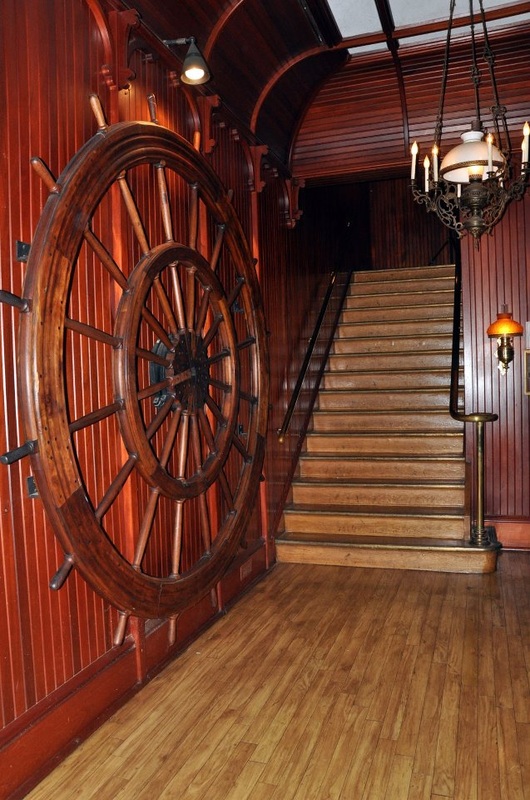
A fine pilot wheel in the entry of "The Belle Venue" in Memphis, Tennessee
THE "BELLE VENUE" IN MEMPHIS HAS AN EXTERIOR ENTRY THAT LOOKS LIKE A TRUNCATED STEAMBOAT STYLE WEDDING CAKE. AMONG THE PHOTOS ONLINE YOU CAN SEE THEIR FANCY VICTORIAN CEILING IN THE DINING ROOM WITH STEAMBOAT GINGERBREAD, BETWEEN THE CEILING AND "BULKHEADS," EVEN A "STERNWHEEL" AT THE REAR OF THE BIG ROOM WITH A PANORAMIC MURAL OF OLD MEMPHIS.
THE BEST THING THAT THEY HAVE IS WHAT HAS TO BE AN ORIGINAL DELUXE PILOT WHEEL IN THE ENTRY WHICH WOULD BE WORTH THE PRICE OF ADMISSION.
thebellebymaxx.com
The Belle Venue
"INSPIRED BY THE MAJESTIC RIVERBOATS OF THE MIGHTY MISSISSIPPI"
Looking for a unique facility for your next special event? The Belle Venue historical cruise themed event facility is the perfect place. This vintage ballroom with its majestic riverboat theme and historic elegant flair is a hidden treasure of the city.
The riverboat themed facility was originally built in 1973. It was a hospitality venue as the Schlitz Belle and later operated as the Stroh's Belle and later Coors Belle which is now known as "The Belle Venue". The Belle ballroom emulates an elegant riverboat overlooking a hand-painted mural of Mississippi River boats from yesterdays. The hand-crafted ceiling, tables and chairs, along with antique chandeliers and wall-mounted sconces reflect a Riverboat Theme while offering an incredible river view.
The historical landmark Grand Ballroom offers guests a grand facility for wedding, receptions, anniversary dinners, corporate events, galas, conferences, quinceanera, reunions, theme parties, proms, and more.
This unique ballroom accommodates up to 250 guests. The Texas Deck holds up to 75 guests and is an excellent space for showers, corporate meetings, Anniversaries, theme parties, and networking events.
The Belle provides historic charm, sophisticated elegance, and a location away from the crowded downtown area.

Original Pen and Ink Drawing with Boats from a St. Louis bakery/coffee shop placemat.
Attached original pen and ink sketch that was the second picture in triptych of St. Louis history on a place mat for Teutenberg's Bakery & Coffee Shop at 10012 Manchester in St. Louis. This sketch could have been either conceptual art for one of the murals in the Manchester restaurant or a sketch based on the mural of the Eads Bridge and boats that could be glimpsed in a tiny detail of a photo that was taken there.
Boats here are cartoonized. Under the bridge are a sidewheel packet boat a towboat that's pushing barges. In the foreground are a wharf boat and a showboat possibly meant to represent the GOLDENROD that was at Laclede's Landing for many years then was moved to St. Charles for a while and finally was retired to a desolate location on the Illinois River where it was permitted to deteriorate until it was beyond restoration and in due course it has probably been dismantled by now.
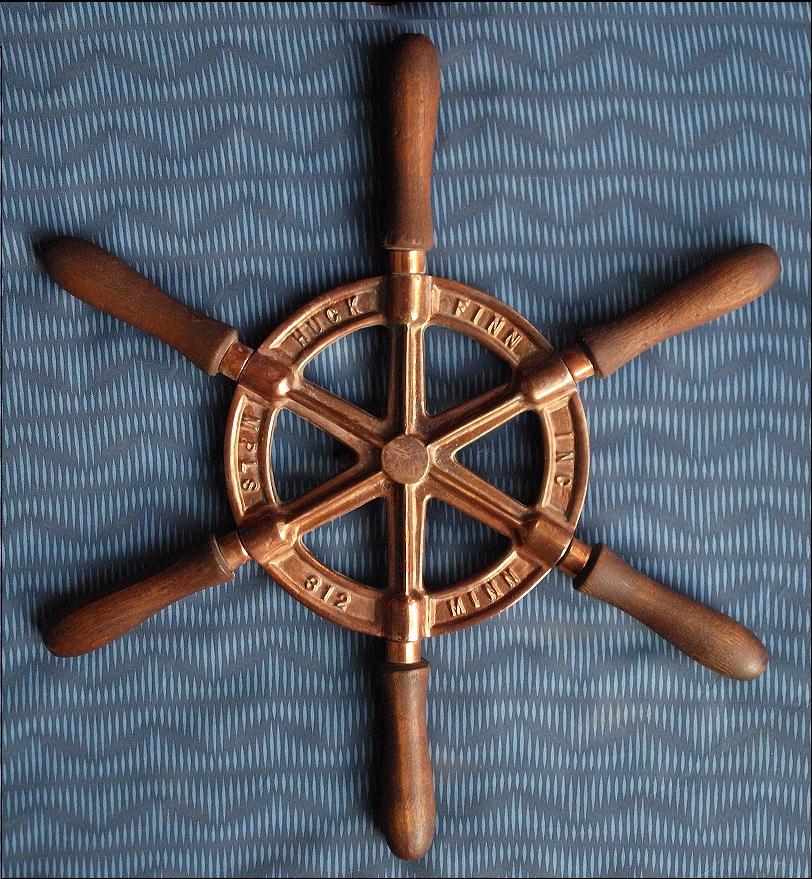
Photo of mini-pilot wheel manufactured by HUCK FINN Incorporated of Minneapolis Minnesota. This would fit on a pontoon boat or some other small craft. Measures 15 inches across, got it on eBay from a dealer in Niceville, Florida . . . the town's name would lend itself to be a title for a T.V. series about a superhero's boyhood hometown.
The metal portion originally had an aluminum finish, I had it copper plated, gave it a patina & re-stained the handles. Want to mount it on a circular wooden plaque for display eventually.
From a recent eBay listing of Stock Certificate Number 25591 for HUCK FINN Inc. Dated 11 April 1973
"Huck Finn, Inc. was incorporated in Minnesota and was based in Minneapolis, Minnesota
The company was produced a number of plastic/polyethylene products, covering a variety of industries.
Huck Finn patented a plastic beer keg, which was designed to reduce the weight of the keg compared to traditional metal kegs. The company also manufactured pontoon boats (one was known as the "Idle Hour") for consumers, featuring the company's patented pontoon system."
Photo of mini-pilot wheel manufactured by HUCK FINN Incorporated of Minneapolis Minnesota. This would fit on a pontoon boat or some other small craft.
Measures 15 inches across, got it on eBay from a dealer in Niceville, Florida . . . the town's name would lend itself to be a title for a T.V. series about a superhero's boyhood hometown.
The metal portion originally had an aluminum finish, I had it copper plated, gave it a patina & re-stained the handles. Want to mount it on a circular wooden plaque for display eventually.
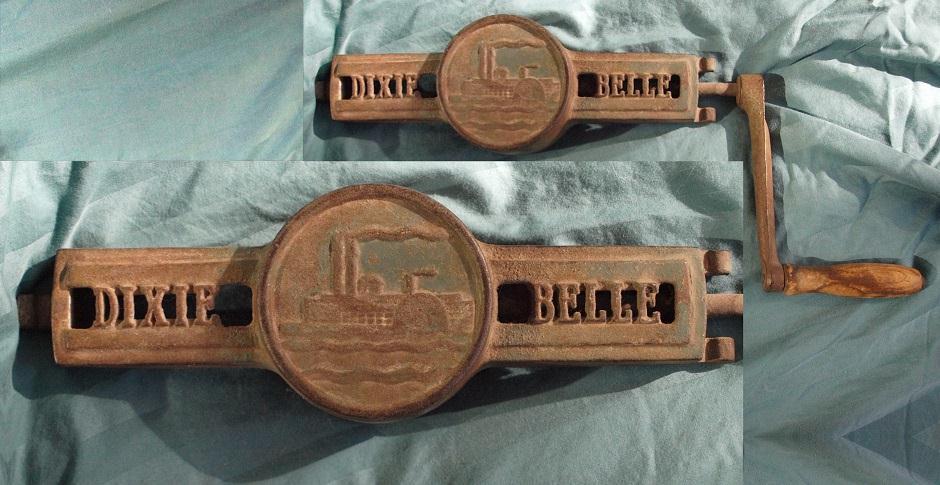
Dixie Belle Ice Cream Maker (Cast iron crank mechanism)
Vintage Dixie Belle Ice Cream Maker made of cast iron 12" long x 2" wide x 1 3/4 inches deep. Circle vignette of the steamboat at center is 3 3/4 inches in diameter. This item would have been clamped across the top of an approximately 16 inch tall wooden bucket. Made by Woodenware Richmond Cedar Works Manufacturing Corporation of Richmond, Virginia. An intact version of this ice cream maker with wooden bucket was listed by NewLife4OldTreasures on Etsy in December, 2017). etsy.com I've had the mechanism in the attached photos for many years and finally got around to photographing it today.

An Elgin watch with steamboat graphic. Not certain of the vintage. Will have to get a jeweler to open it up and give me a run down on the serial number, date etc.
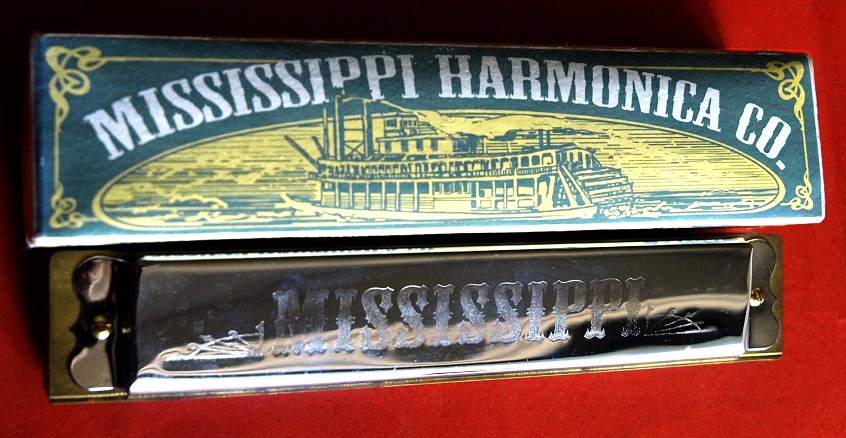
MISSISSIPPI HARMONICA CO.
REGAL No.96235 Made in CHINA 1990
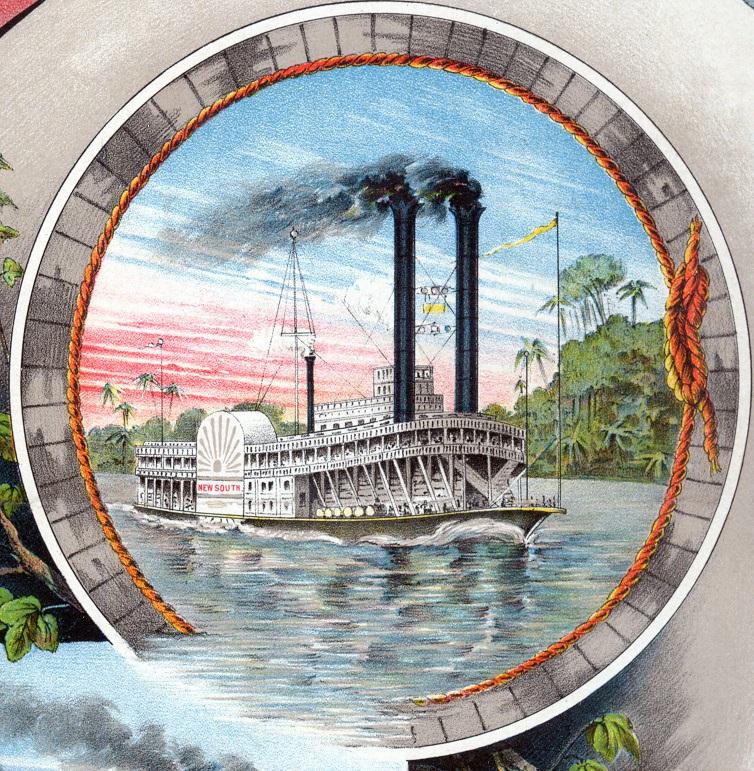
A circular vignette from the cover of the "1889-1890" Christmas catalogue published by the Atlanta, Georgia manufacturer THE "DIXIE" COMPANY. Don't know what they made but a graphic of the factory in the cover is huge and has two big chimneys plus a lot of smaller ones spouting smoke.
NEW SOUTH
Sidewheel Packet
Way's Packet Directory Number 4189
Built in 1887 at Jeffersonville, Indiana. Hull built by Howard Ship Yard
Home port or owner's residence circa 1887, Cincinnati, Ohio. Original price: $32,500. She was built for the Evansville-St. Louis trade but proved to be too large.
In 1890 she entered into the Louisville-Cincinnati trade in opposition to the Fleetwood of the U.S. Mail Line. She made only one stop: Madison, Indiana.
The two rival boats attracted a lot of attention and passenger fare dropped to fifty cents per round trip including meals and berth.
Both boats were laid up by low water and during the summer lull the NEW SOUTH was purchased by the Mail Line and began running Cincinnati-Memphis.
In the summer of 1894, she ran in the Cincinnati-Coney Island trade teamed up with the BOSTONA. In February 1896 she ran a Mardi Gras trip from Cincinnati to New Orleans.
On a trip to St. Louis in October 1896 she got in a windstorm near Harrisonville, Illinois and disabled a wheel when she hit some piling. The C.W. BATCHELOR took off her passengers and freight.
In 1902 she ran a Mardi Gras trip from Cincinnati. She hit an obstruction downbound on the Ohio River and sprung her cabin so badly that hundreds of blankets were bought at Cairo to stuff in the cracks. On February 12, 1905 the ice gorge broke at Cincinnati. The NEW SOUTH broke loose and was so badly damaged that she was dismantled at Madison, Indiana. She apparently gave her original engines to the GREY EAGLE and thereafter she had compound machinery.
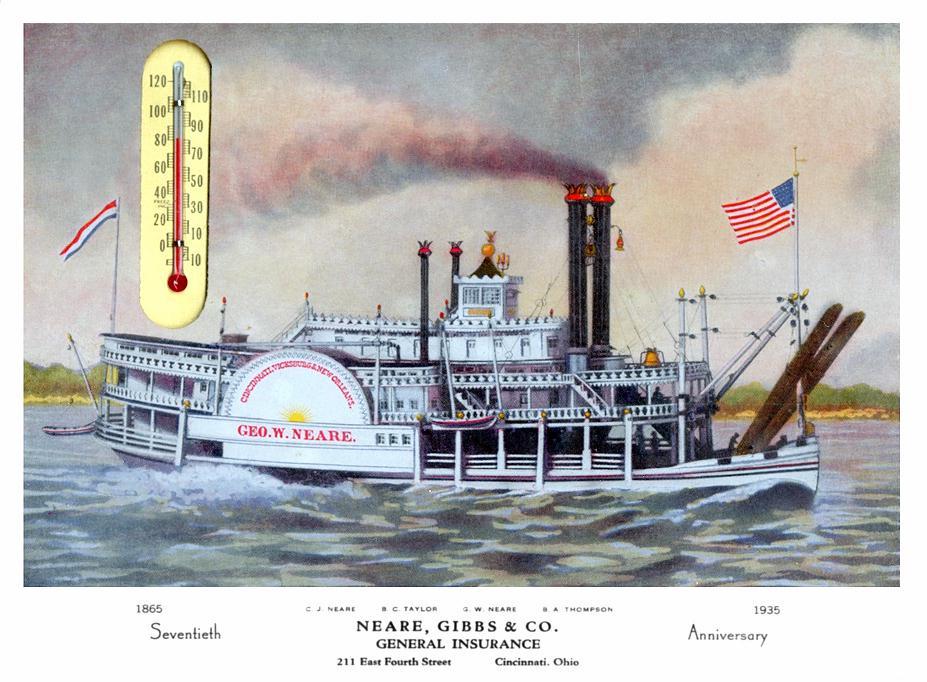
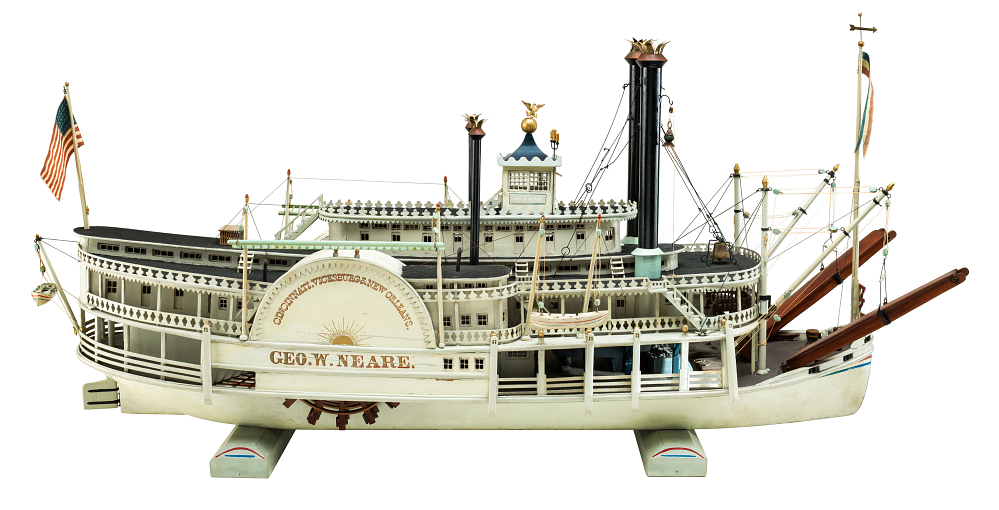
GEO. W. NEARE promotional thermometer and Scale Model
Promotional thermometer for Neare, Gibbs amp; Co. Cincinnati, OHIO 70th anniversary commemorative. 7 3/4's x 9 1/2 inches. I've had this for many years and it is framed under glass which is why the text, painting of the boat and the thermometer are all a bit "fuzzy."
A totally charming model was made in 1920 of what was called the GEO.W. NEARE but according to the Smithsonian that owns the model it actually represents the J.S. PRINGLE that Captain Geo. W. Neare ran in the 1850's.
The painting used in the promotional piece must have been based on the model.
Model, George W. Neare
http://americanhistory.si.edu/collections/search/object/nmah_1314202
This model is incorrectly named after George W. Neare, a former steamboat captain who went into the insurance business in 1865.
By 1889, Neare, Gibbs, and Company were the main river agents for the Insurance Company of North America, whose successor company CIGNA, donated this model to the Smithsonian.
According to a CIGNA article, this model constructed by the boat's engineer is actually of the steamboat J. S. PRINGLE, which Neare captained in the 1850s. Measuring 307 tons, J. S. PRINGLE was built in 1854 in Brownsville, PA for Captain William Stoops, who ran a ferry service across the Ohio River. It was sold in 1855 and moved to the Missouri River. J. S. PRINGLE Pringle ran from St. Louis to St. Joseph under Captain William Conley. In 1861 it carried army supplies from Cincinnati to Nashville under Captain George W. Neare. Captain Hazlett ran it from Louisville on the Tennessee River in Spring 1862. In March 1865 it was acquired by the US Quartermaster's Department. Steamboats on the western rivers were notoriously bad risks, having relatively explosive high-pressure engines, wooden hulls, and flammable cargo. A gold finial, projecting uprights and four smokestacks painted black have red and gold spiked crowns. An eagle on a gold ball is on top of the captain's cabin. Two lanterns hang from the smokestacks, and there is a bell on the upper deck. A red, blue and gold emblem is on the bow and an American flag flies at the stern. Made in 1920 by an unknown craftsman.
Overall material used was brass, tin and wood. Measurements overall: 18 inches high x 40 inches long x 12 inches wide.
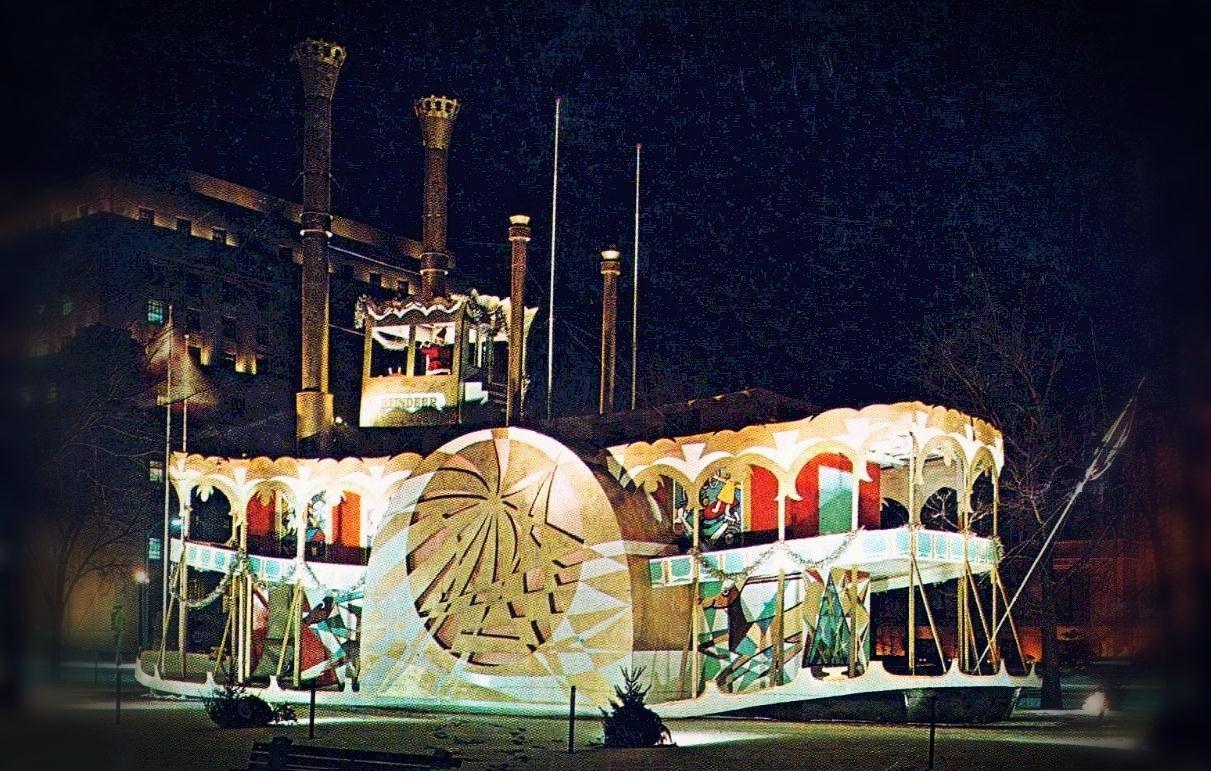
Christmas themed steamboat replica REINDEER
Night time color photo by Jack Zehrt of a charming stylized sidewheel steamboat Christmas themed display taken at St. Louis Memorial Plaza in 1960.
Santa in the pilot house, nice variation on steamboat gingerbread along the boiler deck promenade, leaded glass windows on the bulkheads, sophisticated abstract design on the paddlebox. Would be interesting to new who the artist or artists were who designed this and put it together. It looks like it could have been right at home in the Pasadena Rose Parade. It has a spiritual quality symbolizing your faith in steamboats as floating guardian angels.
Mardigraw Chris'muss!
photojournalismhalloffame.org
JACK J. ZEHRT (1920-2010), noted Midwest photographer, developed a unique, artistic photography style all his own during his 70-year career as a professional North American photographer.
From Route 66 to baseball players to space, St. Louis County photographer Jack Zehrt's wide range of photographs have appeared in ads, magazines, brochures, posters, bank checks, greeting cards and calendars worldwide.
Zehrt's career in photography started after high school in St. Louis, when he worked as a freelancer. A few years later he began working for the St. Louis Globe-Democrat.
In 1943, his first year at the Globe-Democrat, Zehrt won the AP's Picture of the Year award for capturing a glider carrying the St. Louis Mayor and nine others as it crashed to the ground. Zehrt was only 23.
Zehrt left the Globe-Democrat in 1955 to become a stock photographer, meaning he decided the subjects of his pictures and marketed them through a New York agency. Most notable are his photos of space, specifically his series of city skylines with the moon hovering above. He developed a relationship with NASA through his "astrophotography," the photographing of objects in space.
His collection also includes hundreds of photos from Route 66, dating to 1947. He made a 1999 calendar using photos only from the Missouri part of 66. Zehrt made several cameras. His portfolio contains remarkable collections of animals in the St. Louis Zoo, of St. Louis Cardinals and other famous baseball players and of construction of the Gateway Arch.
His sports photos have been in wide demand.

With the exception of images credited to public institutions,
everything on this page is from a private collection.
Please contact Steamboats.com for permission for commercial use.*
All captions provided by Dave Thomson, Steamboats.com primary contributor and historian.
